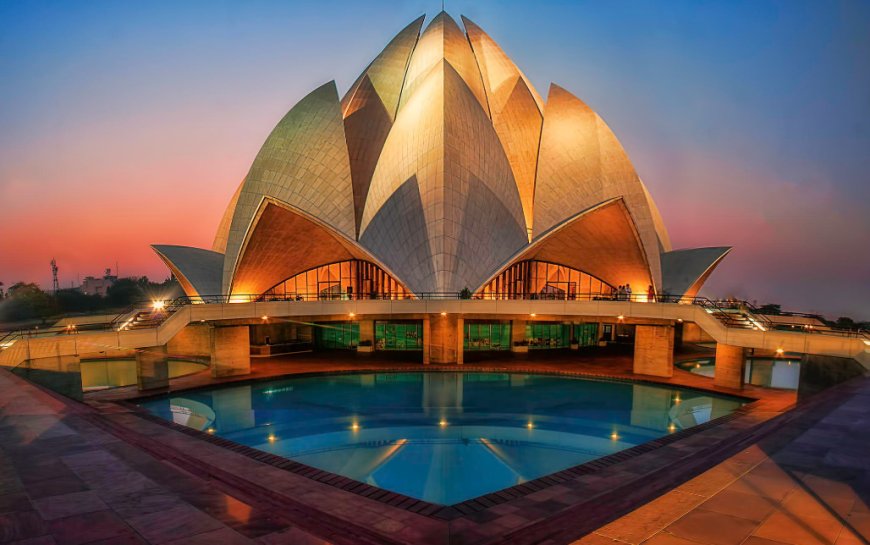From History to Your Visit: The Complete Story of the Lotus Temple
Explore the Lotus Temple's rich history, stunning architecture, and peaceful ambiance, with complete details on timings, location, and how to plan your visit.

From History to Your Visit: The Complete Story of the Lotus Temple
In the heart of New Delhi lies a symbol of peace, unity, and spiritual reflection the Lotus Temple, a place that welcomes people of all religions and beliefs. With its breathtaking architecture and calming ambiance, this iconic structure draws millions of visitors each year. But beyond its beauty lies a deeper story that stretches back decades.
This blog takes you through the full journey of the Lotus Temple from its historical roots to how you can plan a perfect visit today.
The Origins of the Lotus Temple
The Lotus Temple, officially known as the Bahá’í House of Worship, is one of the seven Bahá’í temples around the world. The Bahá’í Faith emphasizes the oneness of God, religion, and humanity and this temple stands as a living example of that principle.
The vision for a Bahá’í temple in India began in the 1950s, but it wasn’t until the 1970s that the dream started taking shape. A plot of land was chosen in Bahapur village, South Delhi, to house what would soon become a marvel of modern architecture and spiritual inclusiveness.
A Marvel of Modern Architecture
The temple’s unique lotus shape was inspired by the symbol of the lotus flower, which is deeply sacred in Indian culture, symbolizing purity and peace. The structure was designed by Fariborz Sahba, an Iranian architect, who envisioned a place that would reflect harmony and openness.
The temple consists of 27 marble-clad “petals”, arranged in clusters of three to form nine sides, with nine doors opening to a central prayer hall. The stunning white marble used in construction was sourced from Penteli mountain in Greece, known for its high quality.
The central hall can hold around 2,500 people at a time. There are no idols, images, or rituals inside—only silence, meditation, and readings from various religious texts, reflecting the Bahá’í belief in unity.
Construction began in 1980 and took six years to complete. The Lotus Temple was opened to the public in December 1986, and it quickly became one of Delhi’s most admired landmarks.
Why the Lotus Temple Is So Special
The Lotus Temple isn’t just admired for its design—it holds deep meaning. It's one of the few places of worship in the world that:
-
Welcomes people of all religions and backgrounds
-
Promotes unity and spiritual reflection
-
Offers a space for silent meditation without rituals or sermons
It’s also a place where interfaith harmony is celebrated. Readings from the Bible, Quran, Bhagavad Gita, and other holy books are often shared during devotional gatherings — showing how different faiths can come together in peace.
How to Visit the Lotus Temple
Planning a visit to the Lotus Temple is simple and enriching. Here’s everything you need to know:
Location:
-
Bahapur, Kalkaji, New Delhi – 110019
-
Easily accessible via Kalkaji Mandir Metro Station (Violet Line), just a short walk away.
Entry Fee:
-
Free for all visitors
Timings:
-
April to September (Summer): 9:00 AM – 7:00 PM
-
October to March (Winter): 9:00 AM – 5:30 PM
-
Closed on Mondays
Best Time to Visit:
-
Early mornings and late afternoons are ideal to avoid the heat and crowds.
-
Weekdays are quieter compared to weekends and holidays.
Visitor Guidelines:
-
Maintain silence inside the prayer hall.
-
Mobile phones should be switched off or silenced.
-
Photography is allowed outside the temple only.
-
Dress modestly and respectfully.
The Lotus Temple Today
Since its opening, the Lotus Temple has won numerous architectural awards and continues to be featured in international travel, culture, and design publications. It has hosted millions of visitors from around the world, including tourists, spiritual seekers, and those simply looking for a moment of peace.
More than a tourist attraction, it serves as a center for spiritual education, community service, and global unity. It has also become an environmental symbol, using solar power to help meet its energy needs.
Final Thoughts
The Lotus Temple is not just a building—it's a place where humanity comes together. Its graceful petals and peaceful halls invite you to pause, reflect, and feel connected beyond borders and beliefs. Whether you're visiting Delhi for the first time or you're a local seeking serenity, the Lotus Temple offers a truly unforgettable experience.
From its visionary history to its welcoming present, the Lotus Temple stands tall as a beacon of harmony, unity, and peace—ready to welcome every visitor with open arms and quiet strength.
Also read: https://ellofacts.com/tanah-lot-temple-bali-a-timeless-sea-shrine-of-spiritual-serenity

 Ellofacts
Ellofacts 





